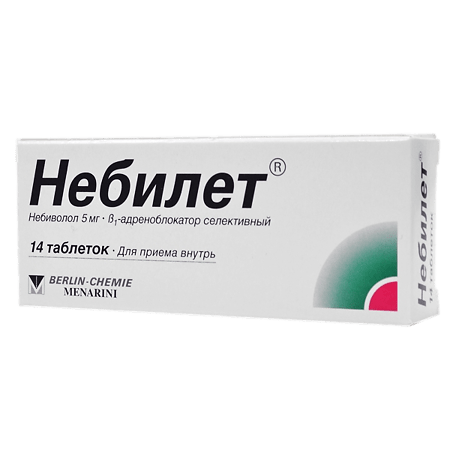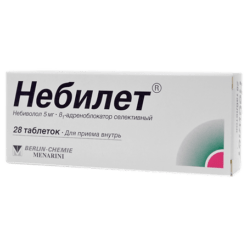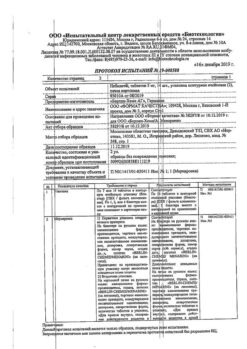No products in the cart.
Nebilet, tablets 5 mg 14 pcs
€23.94 €19.95
Description
Nebilet is antiarrhythmic, hypotensive, antianginal.
Lowering high BP at rest, during physical stress, stress. Competitively and selectively blocks synaptic and extrasynaptic beta1-adrenoreceptors, making them unavailable for catecholamines, modulates the release of endothelial vasodilatory factor (NO). The hypotensive effect is also due to a decrease in the activity of the renin-angiotensin system (does not directly correlate with changes in plasma renin activity).
In the first days of treatment it increases RPS, later on, with long-term use, it is normalized or decreased. Hypotensive effect develops in 2-5 days, stable effect is noted after 1-2 months. It reduces myocardial oxygen demand (lower HR and decrease pre- and post-load), reduces the number and severity of angina attacks and increases exercise tolerance. Antiarrhythmic action is caused by the suppression of pathological heart automatism (including pathological focus) and AV conduction slowing.
Pharmacokinetics
After oral administration it is quickly absorbed from the gastrointestinal tract (food intake has no effect on absorption). Bioavailability – 12% in persons with “fast” (effect of “first passage” through the liver) metabolism and almost full – in persons with “slow”. Protein binding for D-nebivolol – 98.1%, for L-nebivolol – 97.9%.
Metabolized to form active metabolites by acyclic and aromatic hydroxylation and partial N-dealkylation; the resulting hydroxy- and amino derivatives conjugate with glucuronic acid and are excreted as O- and N-glucurones. T1/2 of hydroxymetabolites is 24 h, enantiomers of nebivololol 10 h (for persons with “fast” metabolism); for persons with “slow” – 48 h and 30-50 h, respectively.
Extracted by the kidneys (38%) and intestines (48%).
Indications
Indications
Arterial hypertension, ischemic heart disease.
Pharmacological effect
Pharmacological effect
Nebilet – antiarrhythmic, hypotensive, antianginal.
Reduces high blood pressure at rest, during physical exertion, and stress. Competitively and selectively blocks synaptic and extrasynaptic beta1-adrenergic receptors, making them inaccessible to catecholamines, modulates the release of endothelial vasodilating factor (NO). The hypotensive effect is also due to a decrease in the activity of the renin-angiotensin system (does not directly correlate with changes in renin activity in the blood plasma).
In the first days of treatment, the peripheral vascular resistance increases; later, with long-term use, it normalizes or decreases. The hypotensive effect develops after 2–5 days, a stable effect is observed after 1–2 months. Reduces myocardial oxygen demand (decrease in heart rate and decrease in pre- and afterload), reduces the number and severity of angina attacks and increases exercise tolerance. The antiarrhythmic effect is due to the suppression of pathological automatism of the heart (including in the pathological focus) and the slowdown of AV conduction.
Pharmacokinetics
After oral administration, it is quickly absorbed from the gastrointestinal tract (food intake does not affect absorption). Bioavailability is 12% in individuals with “fast” (the “first pass” effect through the liver) metabolism and almost complete in individuals with “slow” metabolism. Protein binding for D-nebivolol is 98.1%, for L-nebivolol is 97.9%.
Metabolized to form active metabolites by acyclic and aromatic hydroxylation and partial N-dealkylation; the resulting hydroxy- and amino derivatives are conjugated with glucuronic acid and are excreted in the form of O- and N-glucurones. T1/2 of hydroxymetabolites – 24 hours, enantiomers of nebivolol – 10 hours (for persons with “fast” metabolism); for persons with “slow” – 48 hours and 30–50 hours, respectively.
Excreted by the kidneys (38%) and intestines (48%).
Special instructions
Special instructions
The withdrawal of beta-blockers should be carried out gradually over 10 days (up to 2 weeks in patients with coronary artery disease).
Monitoring blood pressure and heart rate at the beginning of taking the drug should be daily.
In elderly patients, monitoring of kidney function is necessary (once every 4-5 months).
For exertional angina, the dose of the drug should ensure that the heart rate at rest is within the range of 55-60 beats/min, and during exercise – no more than 110 beats/min.
Beta-blockers can cause bradycardia: the dose should be reduced if the heart rate is less than 50-55 beats/min.
When deciding on the use of Nebilet® in patients with psoriasis, one should carefully weigh the expected benefits of using the drug and the possible risk of exacerbation of psoriasis.
Patients who use contact lenses should take into account that the use of beta-blockers may reduce the production of tear fluid.
When performing surgical interventions, the anesthesiologist should be warned that the patient is taking beta-blockers.
Nebivolol does not affect plasma glucose concentrations in patients with diabetes mellitus. However, caution should be exercised when treating these patients because Nebilet may mask certain symptoms of hypoglycemia (eg, tachycardia) caused by the use of oral hypoglycemic agents and insulin. Monitoring the concentration of glucose in the blood plasma should be carried out once every 4-5 months (in patients with diabetes mellitus).
With hyperthyroidism, beta-blockers can mask tachycardia.
Beta blockers should be used with caution in patients with chronic obstructive pulmonary disease, as bronchospasm may increase.
Beta blockers may increase sensitivity to allergens and the severity of anaphylactic reactions.
Impact on the ability to drive vehicles and other mechanisms that require increased concentration
The effect of Nebilet® on the ability to drive vehicles and operate machinery has not been specifically studied. Pharmacodynamic studies of nebivolol have shown that Nebilet® does not affect psychomotor function.
During treatment with Nebilet® (if side effects occur), caution should be exercised when driving vehicles and when engaging in potentially hazardous activities that require increased concentration and speed of psychomotor reactions.
Active ingredient
Active ingredient
Nebivolol
Composition
Composition
Active ingredients:
nebivolol hydrochloride micronized 5.45 mg, which corresponds to the content of nebivolol 5 mg.
Excipients:
lactose monohydrate – 141.75 mg,
corn starch – 46 mg,
croscarmellose sodium – 13.8 mg,
hypromellose 15 mPa×s – 4.6 mg,
polysorbate 80 – 0.46 mg,
microcrystalline cellulose – 16.1 mg,
colloidal silicon dioxide – 0.69 mg,
magnesium stearate – 1.15 mg.
Pregnancy
Pregnancy
During pregnancy, Nebilet® is prescribed only for vital indications, when the benefit to the mother outweighs the possible risk to the fetus or newborn (due to the possible development of bradycardia, arterial hypotension, and hypoglycemia in the fetus and newborn).
If treatment with Nebilet® is necessary, uteroplacental blood flow and fetal growth should be monitored. Treatment must be interrupted 48-72 hours before delivery.
In cases where this is not possible, it is necessary to establish strict monitoring of newborns for 48-72 hours after delivery.
Nebivolol is excreted in breast milk. If it is necessary to take Nebilet® during lactation, breastfeeding should be stopped.
Contraindications
Contraindications
Hypersensitivity, bronchial asthma, heart failure (in the decompensation stage), severe liver dysfunction, arterial hypotension, severe bradycardia, cardiogenic shock, sick sinus syndrome, AV block II and III degrees, pheochromocytoma, Prinzmetal’s angina, depression, obliterating peripheral vascular disease (“intermittent” claudication), myasthenia gravis, muscle weakness, age up to 18 years (efficacy and safety have not been established).
Side Effects
Side Effects
From the central nervous system and peripheral nervous system: often – headache, dizziness, increased fatigue, weakness, paresthesia; infrequently – depression, nightmares, confusion; very rarely – fainting, hallucinations.
From the digestive system: often – nausea, constipation, diarrhea; infrequently – dyspepsia, flatulence, vomiting.
From the cardiovascular system: infrequently – bradycardia, acute heart failure, AV block, orthostatic hypotension, Raynaud’s syndrome.
From the skin and subcutaneous tissues: infrequently – erythematous skin rash, itching; very rarely – aggravation of psoriasis; in some cases – angioedema.
Other: infrequently – bronchospasm; rarely – dry eyes.
Interaction
Interaction
With the simultaneous use of beta-blockers with blockers of slow calcium channels (verapamil and diltiazem), the negative effect on myocardial contractility and AV conductivity increases.
IV administration of verapamil is contraindicated while using nebivolol.
When nebivolol is used simultaneously with antihypertensive drugs, nitroglycerin or slow calcium channel blockers, severe arterial hypotension may develop (special caution is required when combined with prazosin).
With the simultaneous use of nebivolol with class I antiarrhythmic drugs and amiodarone, the negative inotropic effect may be enhanced and the time of excitation through the atria may be prolonged.
With simultaneous use of nebivolol with cardiac glycosides, there was no increase in the effect on slowing down AV conduction.
The simultaneous use of nebivolol and drugs for general anesthesia may suppress reflex tachycardia and increase the risk of developing arterial hypotension.
There is no clinically significant interaction between nebivolol and NSAIDs.
Concomitant use of nebivolol with tricyclic antidepressants, barbiturates and phenothiazine derivatives may enhance the hypotensive effect of nebivolol.
Pharmacokinetic interaction
With simultaneous use of nebivolol with drugs that inhibit serotonin reuptake, or other drugs that are biotransformed with the participation of the CYP2D6 isoenzyme, the concentration of nebivolol in the blood plasma increases, the metabolism of nebivolol slows down, which can lead to the risk of bradycardia.
When used concomitantly with digoxin, nebivolol does not affect the pharmacokinetic parameters of digoxin.
With simultaneous use of nebivolol with cimetidine, the concentration of nebivolol in the blood plasma increases.
The simultaneous use of nebivolol and ranitidine does not affect the pharmacokinetic parameters of nebivolol.
With simultaneous use of nebivolol with nicardipine, the concentrations of active substances in the blood plasma increase slightly, but this does not have clinical significance.
Concomitant use of nebivolol and ethanol, furosemide or hydrochlorothiazide does not affect the pharmacokinetics of nebivolol.
No clinically significant interaction between nebivolol and warfarin has been established.
When nebivolol is used concomitantly with insulin and oral hypoglycemic agents, the symptoms of hypoglycemia (tachycardia) may be masked.
Overdose
Overdose
Symptoms: marked decrease in blood pressure, nausea, vomiting, cyanosis, sinus bradycardia, AV block, bronchospasm, loss of consciousness, cardiogenic shock, coma, cardiac arrest.
Treatment: gastric lavage, taking activated carbon. In case of a pronounced decrease in blood pressure, it is necessary to place the patient in a horizontal position with elevated legs, and, if necessary, administer intravenous fluids and vasopressors.
For bradycardia, 0.5-2 mg of atropine should be administered intravenously; if there is no positive effect, a transvenous or intracardiac pacemaker may be installed. In case of AV blockade (II-III stage), intravenous administration of beta-adrenergic stimulants is recommended; if they are ineffective, the issue of installing an artificial pacemaker should be considered.
In case of heart failure, treatment begins with the administration of cardiac glycosides and diuretics; if there is no effect, it is advisable to administer dopamine, dobutamine or vasodilators.
For bronchospasm, IV β2-adrenergic receptor stimulators are used. For ventricular estracystole – lidocaine (class IA antiarrhythmic drugs cannot be administered).
Storage conditions
Storage conditions
At 15–30 °C
Shelf life
Shelf life
3 years
Manufacturer
Manufacturer
Berlin-Chemie AG, Germany
Additional information
| Shelf life | 3 years |
|---|---|
| Conditions of storage | At 15-30 °C |
| Manufacturer | Berlin-Chemie AG, Germany |
| Medication form | pills |
| Brand | Berlin-Chemie AG |
Other forms…
Related products
Buy Nebilet, tablets 5 mg 14 pcs with delivery to USA, UK, Europe and over 120 other countries.
















